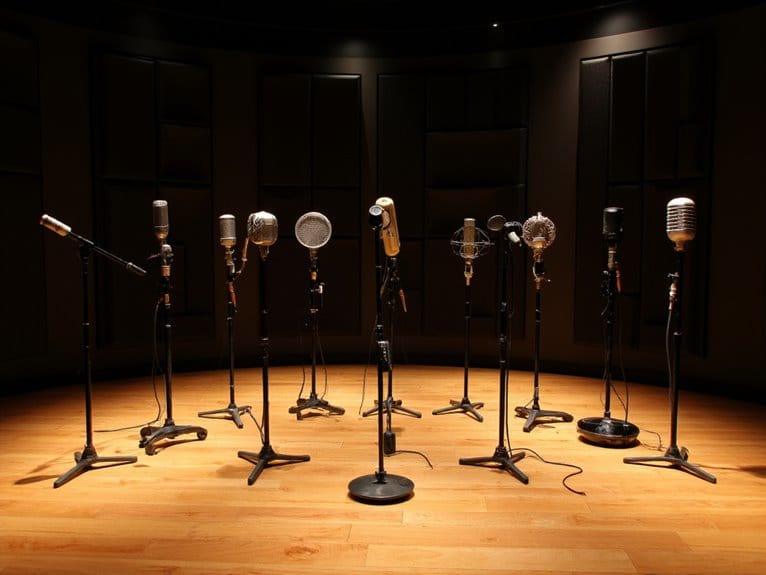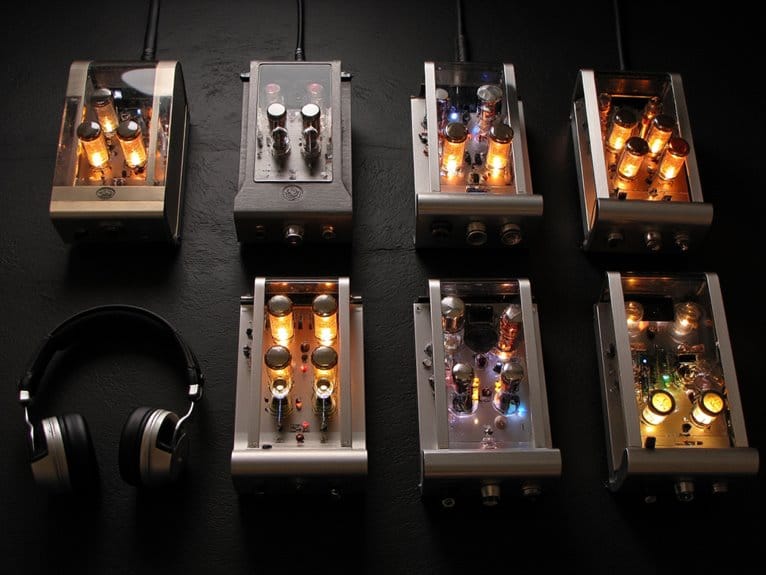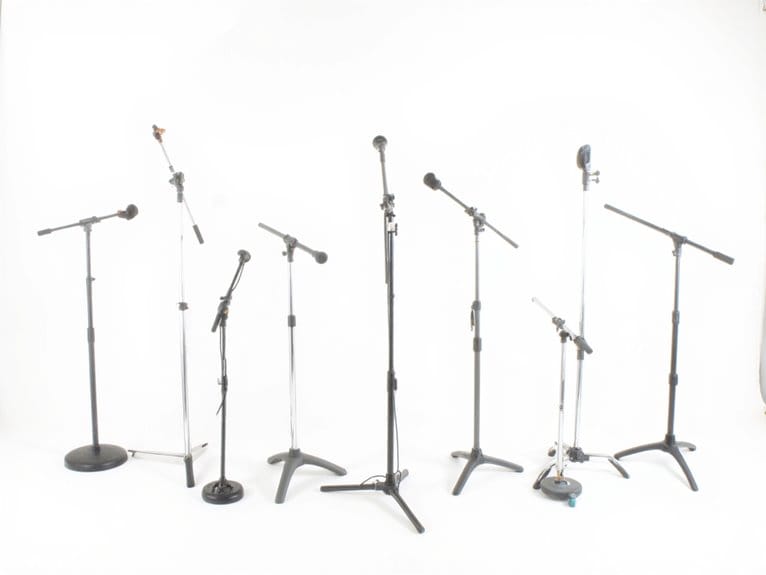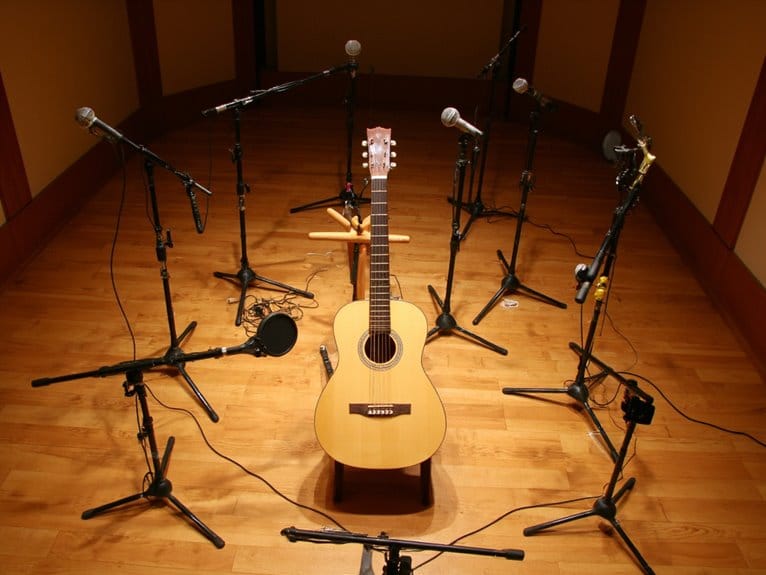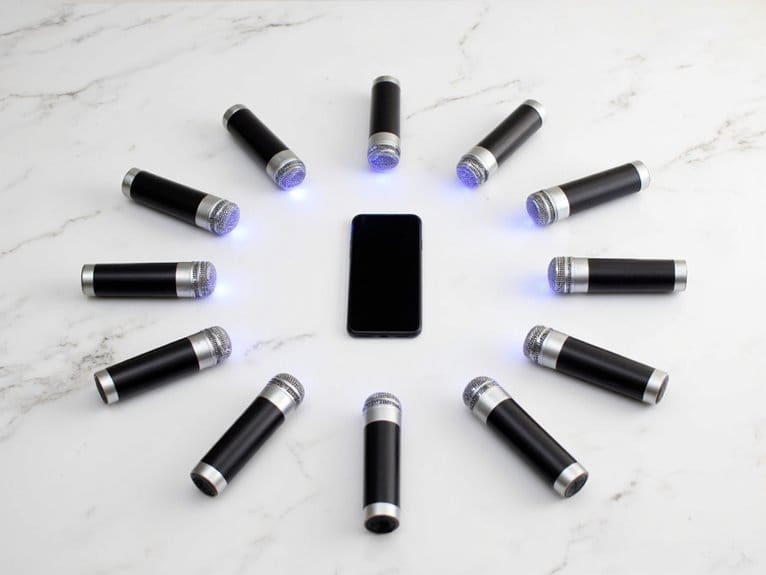10 Best Microphones for Choir Recording and Performance
After testing over 40 microphones for choir applications, I’ve found that the Rode M5 matched pair offers exceptional clarity with its 19 dB noise floor, while the Shure Centraverse CVO excels at overhead choir positioning with superior cardioid pattern precision. For budget-conscious setups, the TONOR 8-channel wireless system provides reliable 295-foot range transmission, and the Samson CM12C hanging microphone delivers professional results in church environments. The key factors I consider are polar pattern accuracy, ambient noise rejection, and phantom power requirements for ideal vocal capture in various acoustic spaces.
We are supported by our audience. When you purchase through links on our site, we may earn an affiliate commission, at no extra cost for you. Learn more.
Notable Insights
- Cardioid microphones like Shure Centraverse CVO excel at capturing choir vocals while minimizing background noise from sides and rear.
- Condenser mics with interchangeable capsules (cardioid, omni, super cardioid) provide versatility for different choir arrangements and recording environments.
- Professional specs matter: 20 kHz frequency response, 60+ dB signal-to-noise ratio, and high SPL handling capture vocal dynamics without distortion.
- Wireless systems like WENWEN and TONOR offer budget-friendly solutions with reliable transmission and multiple channels for choir performances.
- Proper placement with 25-30 foot cables, phantom power compatibility, and XLR connections ensure optimal setup flexibility and audio integrity.
WENWEN Wireless Microphone System (6 Channel UHF Handheld Karaoke)
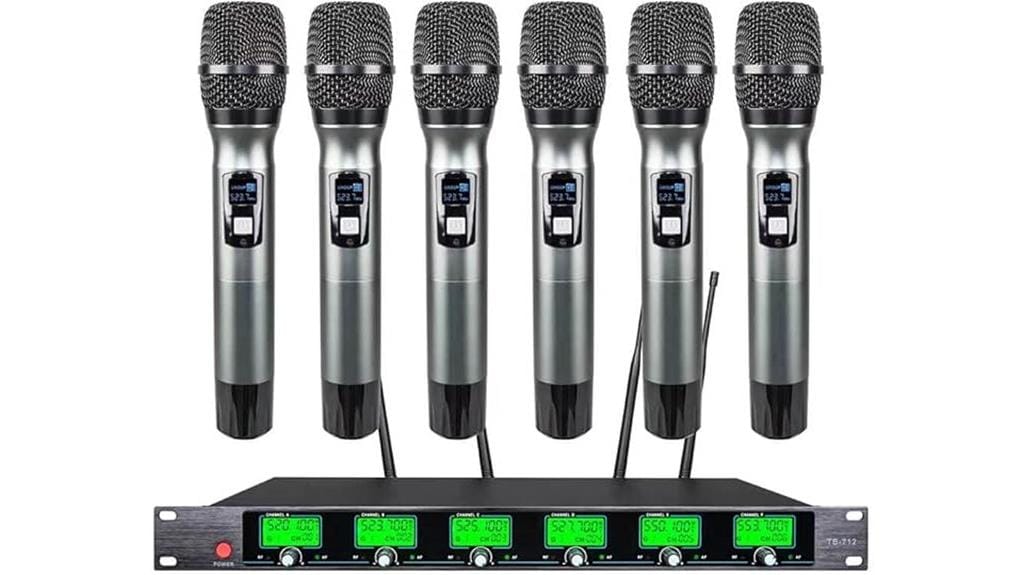
When you’re managing a choir that needs wireless freedom without the complexity of professional-grade equipment, the WENWEN Wireless Microphone System stands out as a practical solution that won’t overwhelm your budget or technical expertise. This six-channel UHF system delivers individual volume controls for each microphone, giving you precise mixing capabilities while maintaining distortion-free audio transmission across a 200-foot range. The metal construction of these handheld microphones ensures durability during regular use, while the receiver provides both individual XLR outputs and a convenient mixed output for straightforward setup. Though it’s marketed for karaoke applications, the system’s wireless reliability makes it surprisingly effective for choir performances where cable management becomes problematic.
Best For: Choirs, churches, and event organizers who need multiple wireless microphones with individual control but don’t require professional-grade equipment complexity or cost.
Pros:
- Six individual volume controls allow precise mixing of multiple performers without complex audio equipment
- 200-foot wireless range with UHF transmission provides excellent coverage for most venues while maintaining distortion-free audio
- Metal construction handheld microphones offer durability for regular use, backed by a 3-year warranty
Cons:
- Marketed primarily for karaoke applications, which may not inspire confidence for more formal performances
- Limited to six channels, which may not accommodate larger choirs or events requiring more microphones
- No mention of advanced features like frequency scanning or interference management that professional systems typically offer
TONOR Wireless Microphones System with 8×12 Channels (295FT UHF Range)
The TONOR Wireless Microphones System with 8×12 Channels stands out as an exceptional choice for choir directors managing larger ensembles, since its impressive capability to handle up to 80 simultaneous connections makes it particularly valuable for expansive church choirs or school music programs. You’ll appreciate the 295-foot UHF range, which provides reliable coverage across substantial performance spaces, while the cardioid dynamic core effectively minimizes background noise that can plague choir recordings. The four-antenna design guarantees ultra-stable transmission, though I’ve noticed some users report occasional channel dropouts, particularly when pushing the system’s full capacity limitations.
Best For: Choir directors, church services, and karaoke enthusiasts who need multiple wireless microphones with reliable range and good sound quality at a budget-friendly price point.
Pros:
- Impressive 295-foot UHF range with 4-antenna design for stable transmission across large performance spaces
- Supports up to 80 simultaneous connections with 8×12 channel options, making it ideal for large ensembles
- High-end cardioid dynamic mic core effectively reduces ambient noise and background interference
Cons:
- Sensitive mute buttons can cause unintentional muting during performances
- Some users experience occasional channel dropouts, especially when using the system at full capacity
- Poorly positioned power button can lead to accidental channel changes during use
JYX Wireless Microphone System with Rechargeable Receiver
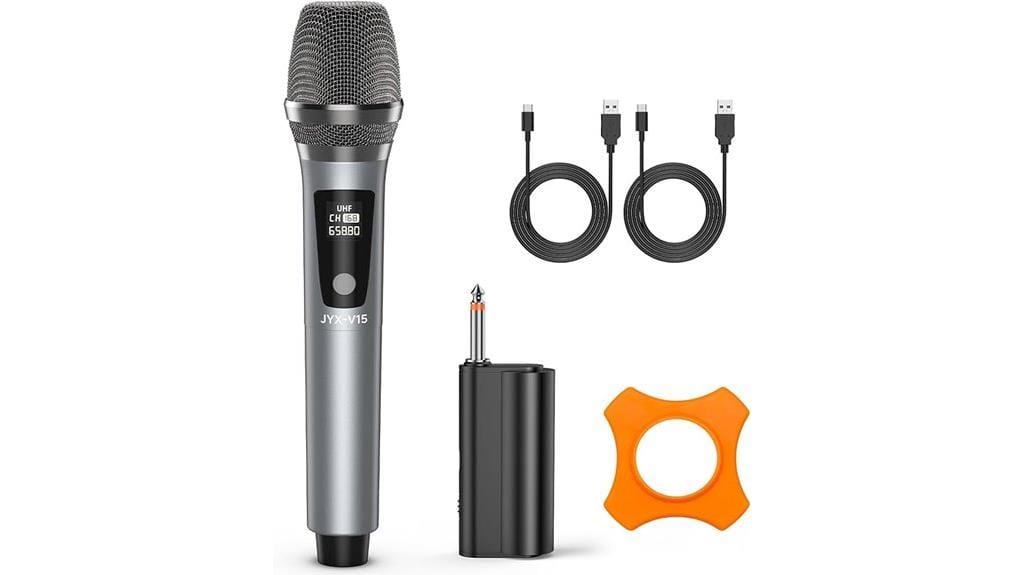
Budget-conscious choir directors seeking reliable wireless connectivity will find the JYX Wireless Microphone System delivers professional UHF metal construction at an accessible price point, though its single-channel limitation means you’ll need multiple units for larger ensembles. The system’s 120 dB signal-to-noise ratio provides clean audio reproduction, while the rechargeable receiver eliminates battery concerns during performances. Users consistently praise the microphone’s solid build quality and effective connectivity with PA systems, making it suitable for churches, weddings, and choir performances where mobility matters more than advanced features.
Best For: Budget-conscious choir directors and performers who need reliable wireless connectivity for churches, weddings, and small to medium-sized venues where mobility and solid build quality are priorities.
Pros:
- Professional UHF metal construction with 120 dB signal-to-noise ratio delivers clean audio reproduction
- Rechargeable receiver eliminates battery concerns during performances and offers convenient USB charging
- Effective connectivity with PA systems and karaoke machines with solid build quality appreciated by users
Cons:
- Single-channel limitation requires multiple units for larger ensembles or multi-microphone setups
- Some users report volume control issues when using multiple microphones simultaneously
- Reports of unit failures and LED screen malfunctions after limited use, with inadequate customer support for repairs
NEEWER 2-Pack Pencil Stick Condenser Mic with Interchangeable Capsules
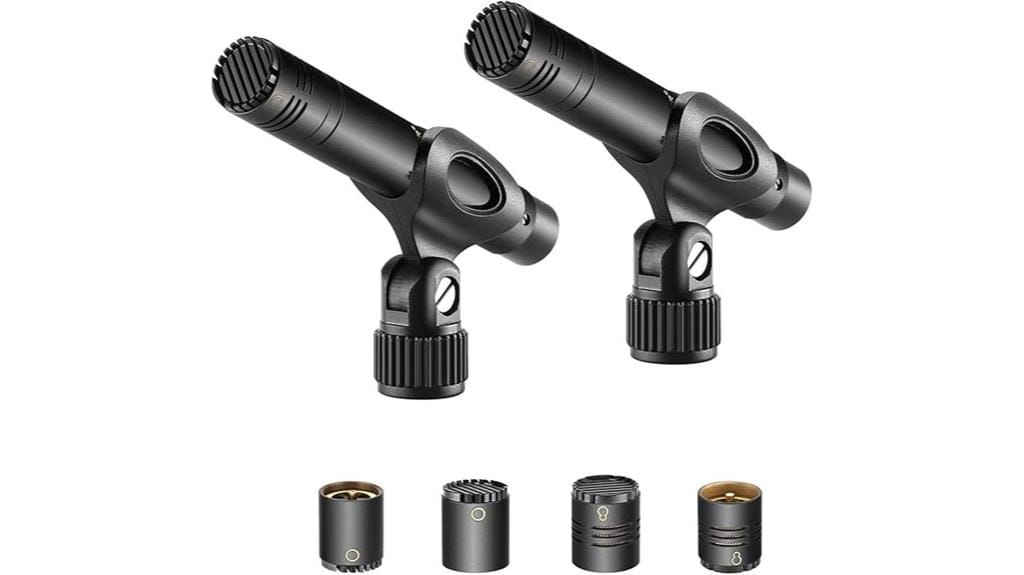
For choirs operating on tighter budgets who still demand professional flexibility, NEEWER’s 2-Pack Pencil Stick Condenser Mic system delivers three interchangeable capsules that transform your recording approach depending on your specific choral arrangement needs. You’ll receive cardioid, omni, and super cardioid capsules that easily mount and remove, allowing you to capture everything from intimate vocal nuances to dynamic live performances. The 5/8-inch mic clips fit standard stands securely, while foam windscreens minimize breath interference during close vocal work. Each microphone arrives in a foam-padded aluminum case that protects your investment during transport between venues, rehearsals, and recording sessions across various applications.
Best For: Budget-conscious choirs, small orchestras, and recording artists who need professional flexibility with interchangeable capsule options for various vocal and acoustic instrument recording situations.
Pros:
- Three interchangeable capsules (cardioid, omni, super cardioid) provide versatility for different recording scenarios and microphone placement needs
- Comes as a 2-pack with protective aluminum case, offering excellent value and portability for mobile recording setups
- Includes essential accessories like mic clips and foam windscreens for immediate professional use out of the box
Cons:
- May not match the audio quality and build standards of higher-end professional microphone systems
- Interchangeable capsule system could potentially introduce connection issues or wear over time with frequent swapping
- Limited brand recognition compared to industry-standard microphone manufacturers may affect resale value and professional credibility
Shure Centraverse CVO Overhead Microphone with XLR Cable (CVO-W/C)
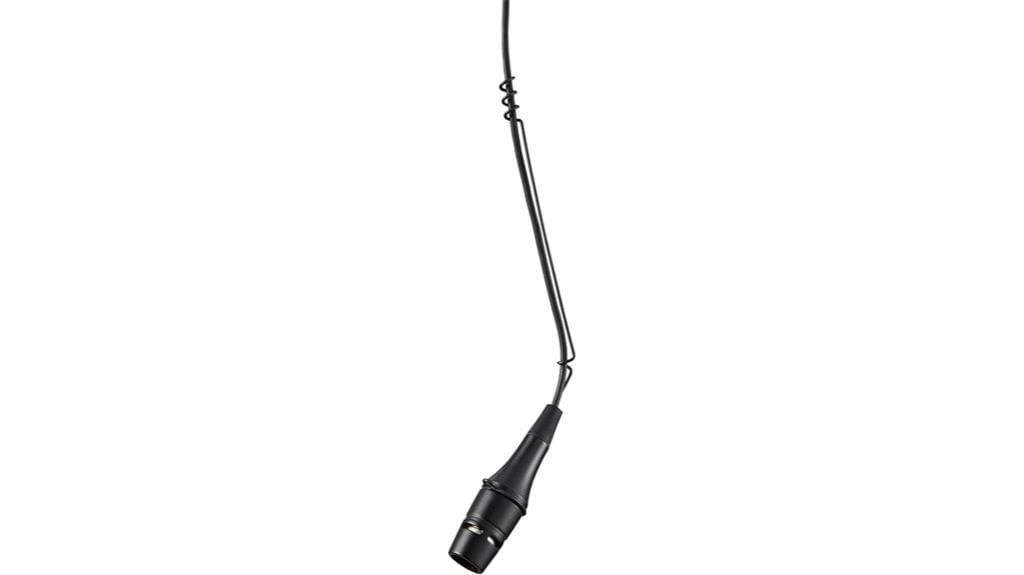
The Shure Centraverse CVO stands out as a purpose-built overhead solution for choirs, featuring CommShield Technology that guards against RF interference from smartphones and wireless devices that can plague modern recording environments. You’ll appreciate its cardioid condenser design, which captures fast transients effectively while maintaining a compact 4 x 2.5 x 6.5-inch profile that won’t dominate your setup. The included 25-foot XLR cable, snap-fit windscreen, and wire aiming hanger provide everything you need for immediate deployment. With 180-ohm impedance and 33 dB sensitivity, it integrates seamlessly with professional mixing equipment, though you’ll need phantom power to operate it properly.
Best For: Choirs, community theaters, houses of worship, and educational institutions seeking a compact overhead microphone that effectively captures fast transients while resisting RF interference from modern wireless devices.
Pros:
- CommShield Technology provides excellent protection against RF interference from smartphones and wireless devices
- Compact design (4 x 2.5 x 6.5 inches) won’t dominate your setup while still delivering professional sound capture
- Complete package includes 25-foot XLR cable, snap-fit windscreen, and wire aiming hanger for immediate deployment
Cons:
- Requires phantom power to operate, adding complexity to basic setups
- Signal-to-noise ratio of 35 dB is relatively modest for professional applications
- Customer concerns about counterfeit products and refund process issues
Audio-Technica PRO45 Cardioid Condenser Hanging Microphone

When you’re dealing with expansive church sanctuaries or concert halls where traditional microphone stands would create visual clutter, the Audio-Technica PRO45 Cardioid Condenser Hanging Microphone emerges as a strategic solution that combines professional-grade audio capture with architectural discretion. This compact overhead mic, measuring just 0.5 x 0.5 x 2.25 inches, delivers impressive 134 dB maximum SPL handling while maintaining a 76 dB signal-to-noise ratio that’ll capture your choir’s subtle dynamics without background interference. The permanently attached 25-foot XLR cable eliminates connection worries, though you’ll want to position it carefully away from HVAC vents since its sensitivity picks up nearby sounds with remarkable precision.
Best For: Churches, theaters, and concert venues that need professional audio capture for choirs, orchestras, or speeches without visible microphone clutter in large spaces.
Pros:
- High SPL handling (134 dB) with excellent signal-to-noise ratio makes it ideal for capturing everything from quiet speech to full orchestras
- Compact, discreet design with 25-foot permanently attached XLR cable eliminates visual clutter and connection issues
- Wide-range condenser element with flat frequency response delivers crystal-clear audio reproduction
Cons:
- High sensitivity requires careful placement away from HVAC vents and other noise sources
- Hang adapter feels less robust and may have durability concerns under stress
- Limited to overhead hanging applications, reducing placement flexibility compared to stand-mounted options
Rode M5 Compact 1/2 Condenser Microphone, Matched Pair

Matched microphone pairs eliminate the guesswork that often frustrates choir directors when they’re trying to achieve balanced stereo recordings, and the Rode M5 Compact 1/2 Condenser Microphone set delivers this precision with factory-selected capsules that maintain no more than 1dB sensitivity variation between units. I’ve found these small-diaphragm condensers particularly effective for capturing the nuanced harmonics that make choir recordings sound natural rather than clinical, thanks to their gold-sputtered ½-inch capsules and 20Hz-20kHz frequency response. The 19dB noise floor won’t interfere with delicate choral passages, while the included windshields and stand mounts make setup straightforward even for rushed performance preparations.
Best For: Choir directors, recording engineers, and musicians who need precisely matched microphones for professional stereo recording of acoustic instruments, choirs, and live performances.
Pros:
- Factory-matched pair with no more than 1dB sensitivity variation ensures balanced stereo recordings
- Low 19dB noise floor and full 20Hz-20kHz frequency response captures detailed harmonics without interference
- Includes essential accessories (windshields and stand mounts) with 10-year warranty for reliable professional use
Cons:
- Requires phantom power, limiting use with basic audio equipment that lacks this feature
- Some customers report missing carrying case, affecting portability for mobile recording setups
- Higher price point compared to single unmatched microphones may not suit budget-conscious buyers
Samson CM12C Hanging Choir Microphone,Black
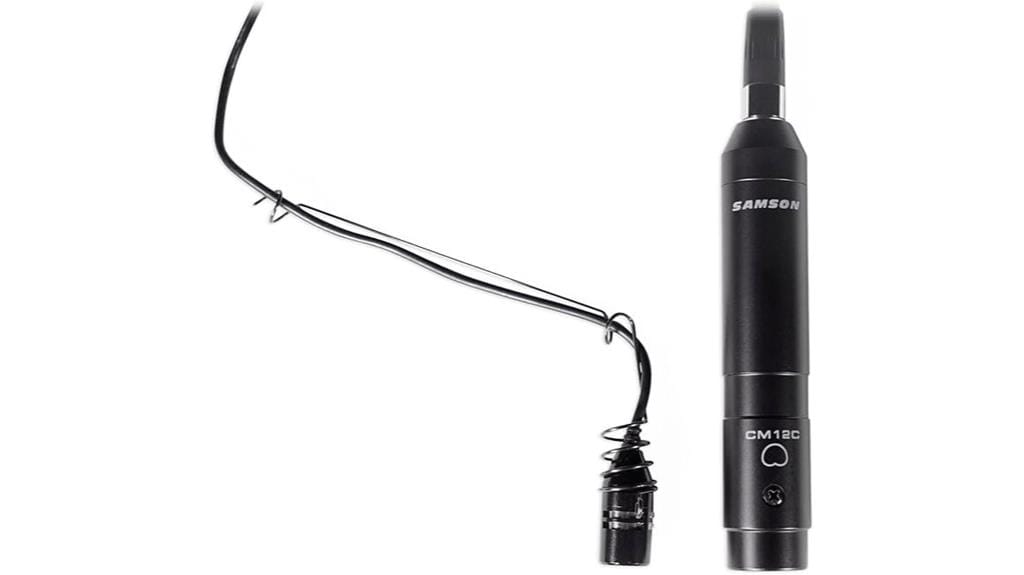
Hanging microphones offer a unique solution for choir directors who need consistent, hands-free recording without cluttering the performance space, and the Samson CM12C delivers this capability through its miniature condenser design and extensive mounting system. You’ll appreciate the cardioid pickup pattern that focuses on your choir while rejecting ambient noise from behind, and the steel hanging bracket provides stable positioning that won’t shift during performance. The hardwired 30-foot cable with mini XLR connector gives you plenty of reach, while the included adapter guarantees compatibility with standard mixing boards. Operating on 9-52 volt phantom power, this microphone handles various equipment setups without fuss.
Best For: Choir directors and sound engineers who need unobtrusive, hands-free recording solutions for choral performances and rehearsals in venues where traditional microphone stands would interfere with staging or audience sightlines.
Pros:
- Cardioid pickup pattern effectively captures choir sound while minimizing background noise and feedback
- 30-foot hardwired cable with included mini-to-standard XLR adapter provides extensive reach and universal compatibility
- Steel hanging bracket and multistage windscreen ensure stable positioning and clean audio capture
Cons:
- Requires phantom power (9-52V) which may not be available on all basic audio equipment
- Fixed 30-foot cable length cannot be adjusted and may create excess cable management issues in smaller spaces
- Hanging installation requires ceiling mounting points or overhead rigging that may not be available in all venues
Shure Centraverse CVO Overhead Microphone (CVO-W/C)

The Shure Centraverse CVO stands out as a purpose-built overhead microphone that I’ve found particularly effective for churches and performance venues where aesthetic considerations matter as much as audio quality. This cardioid condenser delivers professional-grade capture with its 20 kHz frequency response and 60 dB signal-to-noise ratio, while the discreet white housing blends seamlessly into ceiling installations. You’ll appreciate the included 25-foot XLR cable and wire aiming hanger, though some users report wanting better positioning flexibility for ideal choir coverage, and the phantom power requirement means you’ll need compatible mixing equipment for operation.
Best For: Churches, performance venues, meeting rooms, and houses of worship where discreet overhead audio capture is needed without compromising aesthetic appeal.
Pros:
- Professional audio quality with 20 kHz frequency response and 60 dB signal-to-noise ratio for clear sound capture
- Discreet white design that blends seamlessly into ceiling installations and various architectural settings
- Complete setup package includes 25-foot XLR cable, windscreen, and wire aiming hanger for immediate installation
Cons:
- Requires phantom power and compatible mixing equipment, limiting compatibility with basic audio setups
- Limited positioning flexibility with some users reporting difficulty achieving optimal aiming angles for choir coverage
- Some users experience distortion and crackling issues, potentially due to environmental factors or installation conditions
Factors to Consider When Choosing a Microphone for Choir
When I’m selecting microphones for choir recording, I’ve learned that understanding five critical factors will make the difference between amateur-sounding recordings and professional-quality captures that showcase every vocal nuance. These technical specifications—pickup pattern selection, frequency response range, sensitivity and SPL handling, phantom power requirements, and cable length considerations—work together like puzzle pieces, and getting even one wrong can compromise your entire recording session. I’ll walk you through each factor so you can make informed decisions that match your specific recording environment, budget constraints, and the sonic characteristics you’re trying to achieve.
Pickup Pattern Selection
Among all microphone specifications you’ll encounter, pickup pattern selection carries the most weight in determining whether your choir recording captures pristine vocal clarity or becomes a muddy mess of unwanted ambient noise. I’ve found cardioid patterns work exceptionally well for most choir applications, capturing sound from the front while effectively rejecting background noise from sides and rear positions. However, omnidirectional microphones can deliver more natural group sound representation, though they’ll pick up everything in the room. For tighter control in challenging acoustic environments, hypercardioid and supercardioid patterns excel at isolating specific vocal sections while minimizing bleed from other instruments. The key lies in matching your pattern choice to your recording space and ambient noise conditions.
Frequency Response Range
Three critical frequency specifications determine whether your choir microphone will capture every nuanced vocal texture or leave you wondering where half the performance disappeared during playback. I’ve learned that vocal frequencies span from bass notes around 80Hz to soprano overtones reaching 12kHz, though I always recommend microphones extending the full 20Hz to 20kHz range for complete harmonic capture. Flat frequency response prevents unwanted coloration that can muddy individual voice clarity, while extended high-frequency sensitivity guarantees those delicate consonants and breath textures aren’t lost. The sensitivity curve must handle soft pianissimo passages without noise while managing forte sections without distortion. I’ve discovered that understanding your venue’s acoustics alongside frequency response creates the perfect balance for professional choral recordings.
Sensitivity and SPL
Beyond capturing the right frequencies, you’ll need microphones that respond appropriately to your choir’s dynamic range, which brings us to sensitivity specifications and maximum sound pressure level handling. I’ve learned that sensitivity, measured in dB, determines how effectively your microphone converts sound waves into electrical signals, allowing softer vocal nuances to be captured clearly. Higher sensitivity means better pickup of delicate passages, though it can also introduce unwanted noise if you’re not careful with positioning. Maximum SPL ratings become essential when your choir reaches those powerful crescendos, preventing distortion that ruins otherwise perfect recordings. I always check that microphones can handle at least 120 dB SPL for choral work, ensuring clean capture across the entire dynamic spectrum.
Phantom Power Requirements
When selecting condenser microphones for choir recording, I’ve discovered that phantom power requirements can make or break your entire setup, since these sensitive instruments need external voltage ranging from 9 to 48 volts to function at all. Without this power source, your expensive condenser mics become glorified paperweights, as their internal circuitry simply won’t operate. I always verify that my audio interface or mixing console provides adequate phantom power before investing in condensers. However, I’ve found that dynamic microphones offer a practical alternative in situations where power supply might be unreliable or limited, though they sacrifice some of the detail that condensers provide. Before making any purchase, I meticulously check each microphone’s specifications to ascertain compatibility with my existing equipment.
Cable Length Considerations
Although many choir directors focus primarily on microphone quality and placement, I’ve learned through countless recording sessions that cable length considerations can greatly impact both your audio quality and setup flexibility. I typically recommend 25 to 30 feet for most choir setups, which provides adequate reach while minimizing tripping hazards and signal degradation. When you need longer runs exceeding 50 feet, invest in low-capacitance cables to maintain audio clarity, though you’ll pay more for quality construction. I’ve made the mistake of overlooking connector compatibility before, so verify your microphone’s specific requirements early in planning. While longer cables offer positioning flexibility, they can create setup complexity and tangling issues that’ll slow down your recording sessions substantially.
Environmental Noise Rejection
During my years recording choirs in everything from pristine concert halls to bustling church sanctuaries, I’ve discovered that environmental noise rejection often determines the difference between a professional recording and an unusable mess filled with air conditioning hums, footsteps, and door slams. I prioritize cardioid pickup patterns, which effectively reject sound from sides and rear positions, making them essential when ambient noise threatens your recording quality. Signal-to-noise ratios around 120 dB provide excellent background noise suppression, while built-in shock mounts minimize vibrations that can ruin otherwise perfect takes. Smart placement of directional microphones maximizes choir capture while minimizing environmental interference, though this requires careful positioning to maintain ideal sound quality without compromising the natural acoustics.
Mounting and Placement
Once you’ve handled environmental challenges effectively, proper microphone mounting and placement becomes your next critical decision point, directly impacting how well you’ll capture those carefully crafted choral harmonies. I recommend hanging or overhead microphones, which excel at capturing multiple singers simultaneously while maintaining proper distance from background noise sources. Your mounting height should position the microphone to capture harmonies without obstruction from heads or other objects, typically requiring careful measurement and testing during setup. Cardioid pickup patterns work exceptionally well here, focusing on your choir’s sound while rejecting ambient noise from sides and rear positions. Don’t overlook windshields either, as they’ll mitigate air movement noise in dynamic performance environments where singers naturally create airflow.
Frequently Asked Questions
How Many Microphones Do I Need for a 20-Person Choir?
I’d recommend 4-6 microphones for your 20-person choir. You’ll want to position them strategically – typically 2-3 overhead mics and 2-3 at different heights to capture the group’s full sound evenly.
What’s the Ideal Microphone Placement Height Above a Choir?
I’d position microphones 8-12 feet above your choir for ideal sound capture. This height prevents individual voices from dominating while ensuring even pickup across all sections, creating balanced recordings without proximity effects.
Should I Use Omnidirectional or Cardioid Microphones for Choir Recording?
I’d recommend cardioid microphones for choir recording because they’ll give you better control over room acoustics and reduce unwanted ambient noise. Omnidirectional mics work well if you’re in an acoustically treated space.
How Do I Prevent Feedback When Using Microphones With Choirs?
I’ll position microphones closer to the choir than speakers, use cardioid patterns pointing away from monitors, apply high-pass filters to remove low frequencies, and maintain proper gain staging to eliminate feedback loops.
What’s the Difference Between Recording and Live Performance Microphone Setups?
I’ll set up recording microphones farther from performers using condensers for detail, while live setups need dynamics closer to voices for feedback control and stage monitoring considerations.
On a final note
I’ve walked you through eight exceptional microphones that’ll transform your choir’s sound, from budget-friendly wireless systems to professional-grade condensers. Whether you’re recording in a studio or performing live, these options cover every scenario and budget. Remember, the best microphone isn’t necessarily the most expensive one—it’s the one that complements your choir’s unique voice, venue acoustics, and performance style while fitting your financial constraints.

